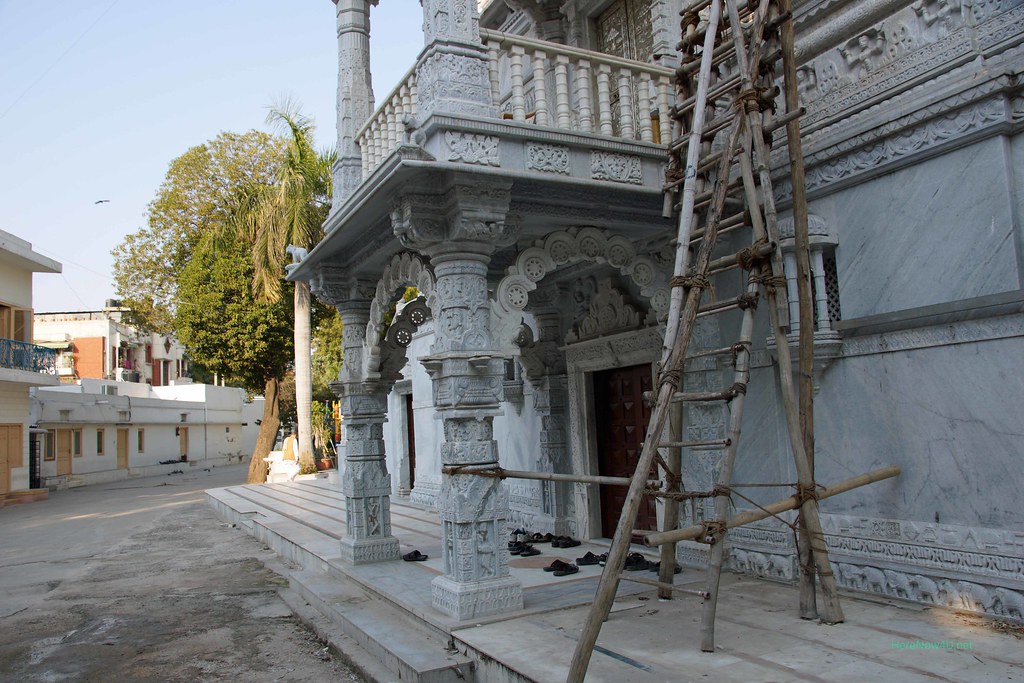
We stopped near the side entrance of the temple, where a ladder was leaned against the wall.
The first temple we visited this afternoon was Chhoti Dadabari Jain Mandir. It is a contemporary Shvetambara Kharatara Gaccha Temple. Kharatara is an image-worshipping and temple attending Sangh of Jainism belonging to Murtipujaka and Mandirmargi Jain communities. Terapanthi to which we belong also are Shvetambara, but do not worship images and do not go to temples. Therefore temples are more or less virgin soil to us which we aim at not only visiting, but also getting more and more spiritual access.
Like some visitors before, we first put off our shoes. To put off shoes not only when visiting temples, but also when entering the home of someone is an act of courtesy spreading more and more all over the world. That’s why some pairs of shoes are visible at the side entrance. Many visitors think it impolite to deposit their leather shoes directly at the main entrance. Not only shoes, but also other objects made of leather like belts, bags, purses, and wallets have to be deposited outside a temple in a gatehouse. The reason is Ahimsa, the principle to turn the back to violence which is observed as much as possible by all Jains. Our rambling view came back from the shoes to the ladder. Had it been forgotten? Anyway, this accumulation of objects gave a funny impression.

But we found out that the ladder was far from being forgotten …
Like the shoes it was like a statement on the temple. The ladder showed that work there still was in progress, and it yet was not completed. This is not too much amazing for a man-made construction, even when it is a sacral building. Which man-made object can be called perfect? Perfect beings are those to who in the special case of a Jain temple praise and honour are directed in the shape of erecting a temple. Who was praised and honoured in this temple, we got to know when visiting the most inner sanctum.
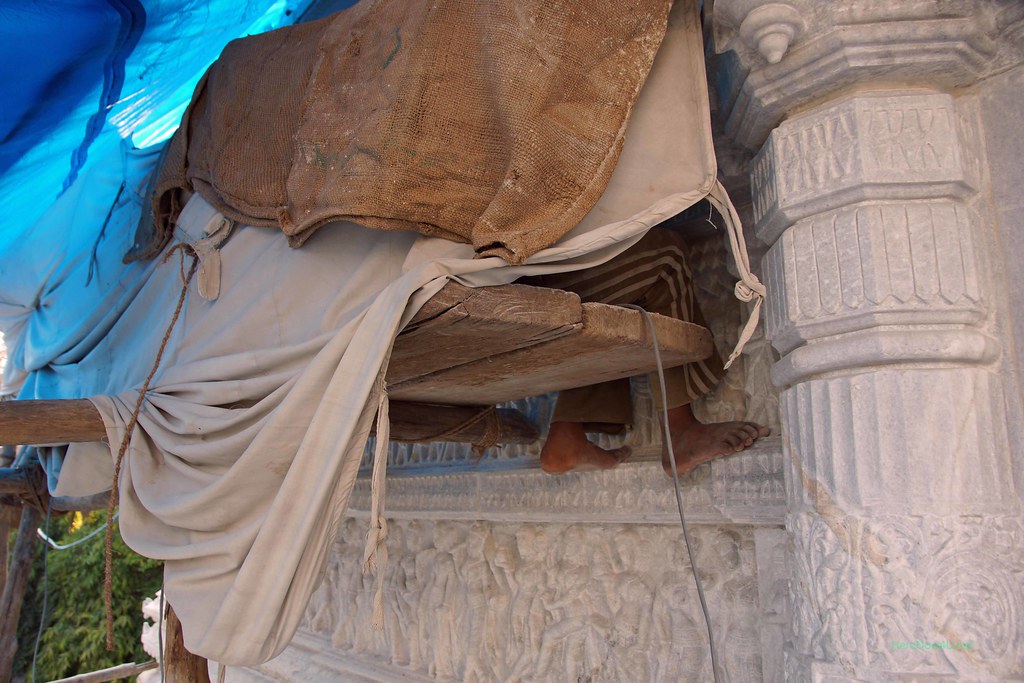
Clear indication of work in progress…
We could not help but smile when discovering these feet. They belonged to a specialist in handicrafts adorning temple facades with colours stimulating happiness. He meticulously highlighted tiny details. This work is demanding a great deal of precision and experience. To tint the tiny depiction on the front of a temple is known as a very difficult task. Any mistake immediately is displayed and layers of paint may be too thick after several tries. So this only may increase the problems. But here was not the slightest trace of slipshod work. This man precisely knew how to place his brushes.

Such are the wonderful pastel colours stimulating feelings of happiness in the viewer.
Damages caused by the weather did not yet any harm to the front of the temple. The pure white marble as well made clear that the temple is a construction of the 21st century. This cannot be recognized by the architectural style or the construction materials, as these still are the same as those well-proved by time and tradition. Jain temples also nowadays are constructed according to the best tradition and a rather broad variety of types.

This corner makes visible the difference between coloured and non-coloured part of the façade.
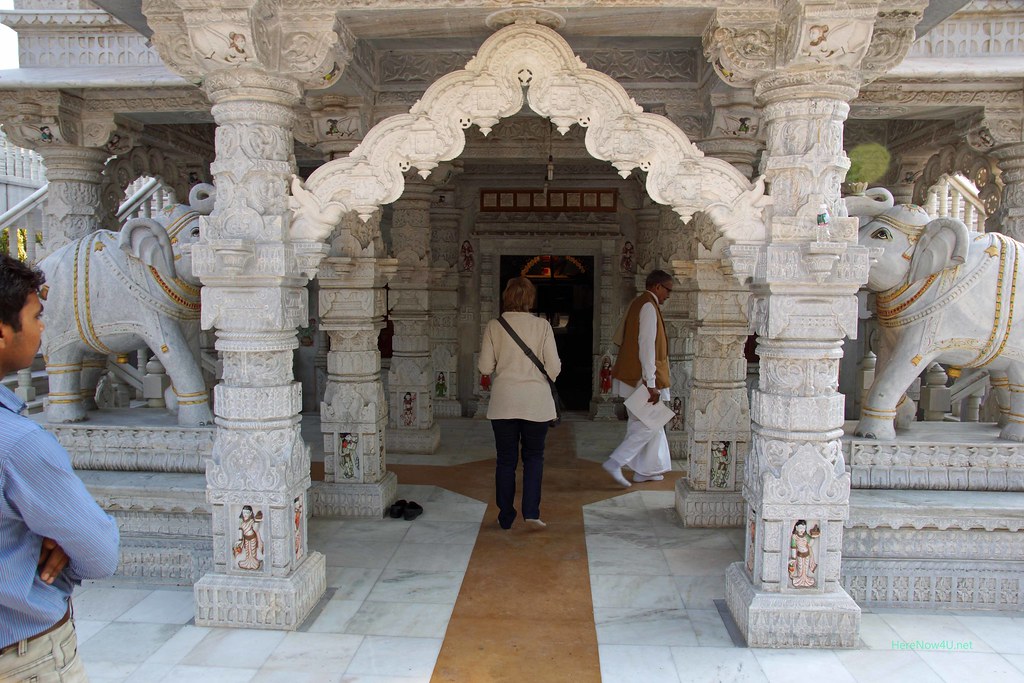
This was the first temple we visited on this India trip, a very promising start.
The entry of the temple is formed by a column-flanked gateway, followed by splendid marble sculptures of elephants. Gateways are symbolizing the subtle spiritual world. In India, depictions of elephants are indicating the high importance of an institution or a construction. Here it is mainly in the figurative sense.[1] Swami Dharmanandji gave us sign to follow him to the upper storey.

There we were awaited by the manager of the temple, who gave the permission to take photos. He kindly took us around and focused our attention on especially beautiful details. Our tour started from the upper storey. First of all we were stunned by the multitude of impressions assailing us. The doors left and right from the open door in the middle were made from pure silver.
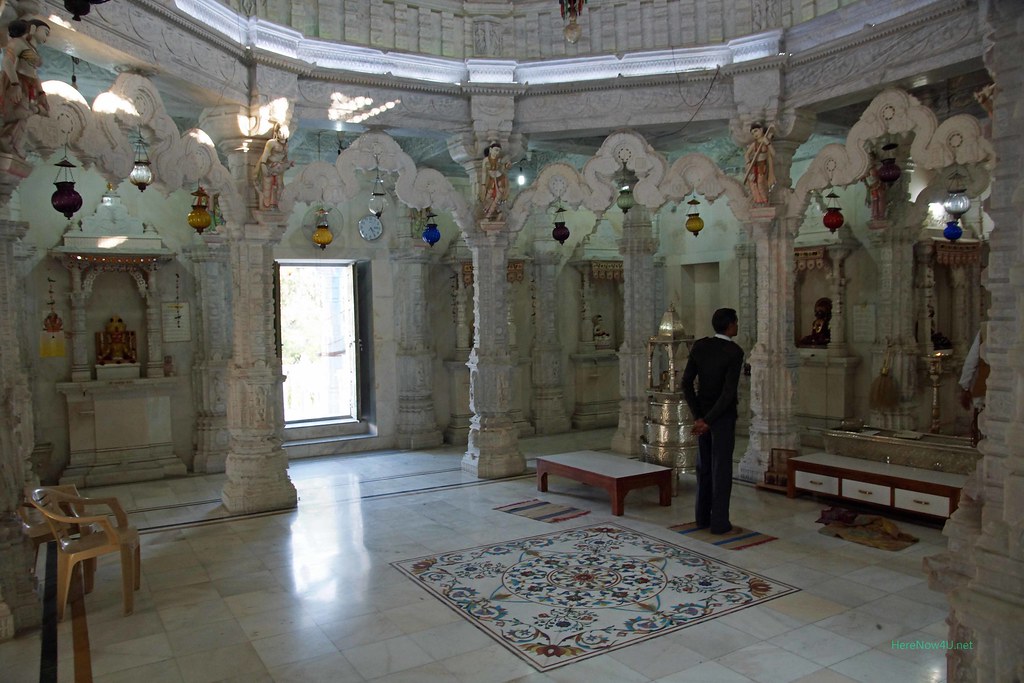
We entered a very bright hall with plenty of wonderful adornments. The sanctum (garbhagriha) was in the middle of the hall.
The sanctum is the innermost sphere of the temple, where the sculpture of the Tirthankara being the main idol of the temple is presented. The main idol usually is flanked by two smaller sculptures of two other Tirthankaras. Before approaching the sanctum, one feels very touched by the subtle energies manifested in the composition of the hall (ranga mandapa).
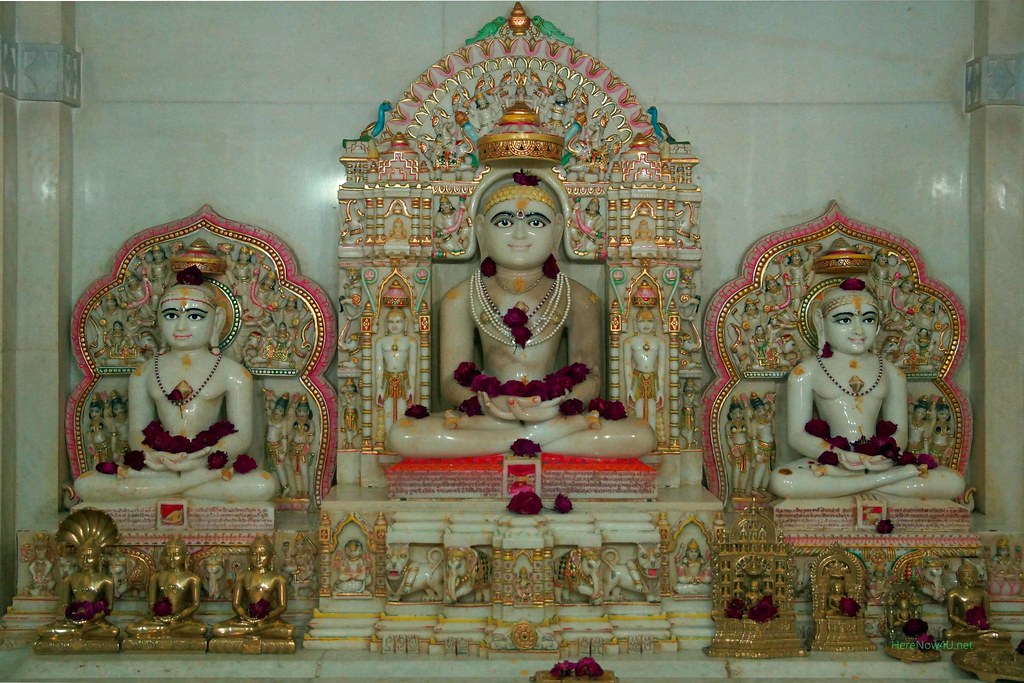 Main idols (middle): Dharmanatha, 15.Tirthankara
Left: Neminatha, 22.Tirthankara
Right: Shantinatha, 16.Tirthankara
Main idols (middle): Dharmanatha, 15.Tirthankara
Left: Neminatha, 22.Tirthankara
Right: Shantinatha, 16.Tirthankara
The main idol of this temple, 15th Tirthankara Dharmanatha (m), is flanked by 22nd Tirthankara Neminatha (l) and 16th Tirthankara Shantinatha.
The sanctum in a Jain temple is like a small temple in the big temple. Here the sculptures made of polished marble are surrounded with depictions of celestial musicians and dancers. The pedestals of the statues were ornamented with elephants and guardians in the shape of celestial beings and huge cat- or lion-like beasts. In front of them 7 gold-plated smaller sculptures of different Tirthankaras. Furthermore all of them were adorned with petals or joined blossoms of fresh roses.
By circling the sanctum, starting left and then clockwise, not only the adoration for the perfect teachers is manifested, but circling also results together with mental concentration on the subtle, uplifting, and superior aspects of human life in a dissolution of karma particles veiling the originally pure and omniscient soul. Visiting a Jain temple initiates this process accessible for humans only to become aware of the subtle potencies acting on life and to be released of their bondage.
A marble passage leads from the part with the sanctum to another edifice on the same level. Externally it is plainer, less adorned. The front consists of simple white marble plaques. The interior imposes with a plain, light-flooded, and very spacious shape of the hall.
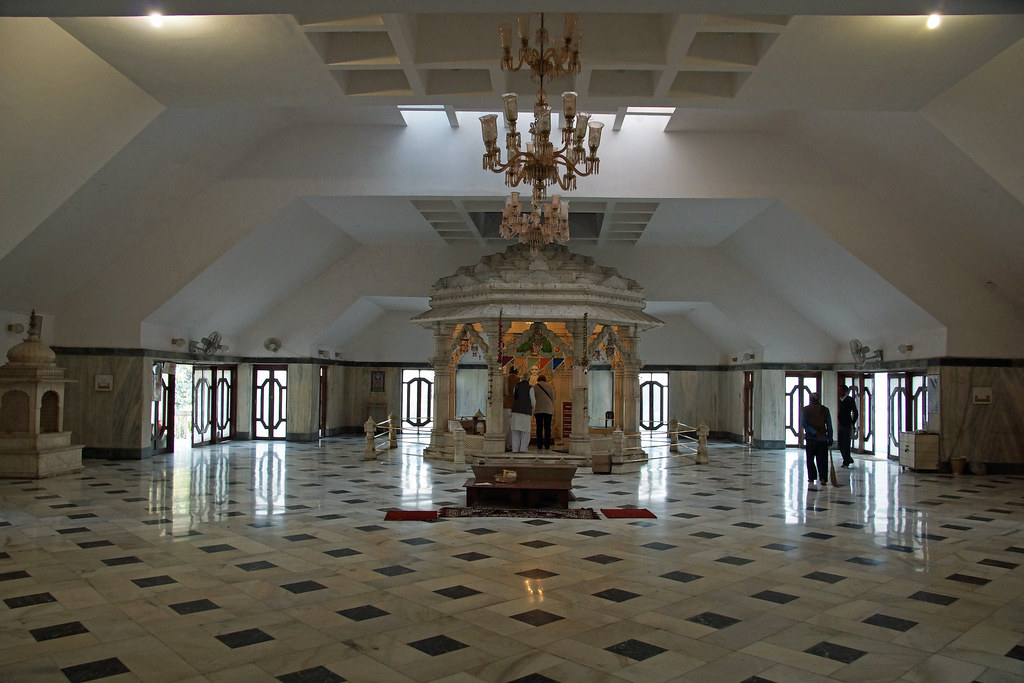
In the middle of the hall was an open pavilion.
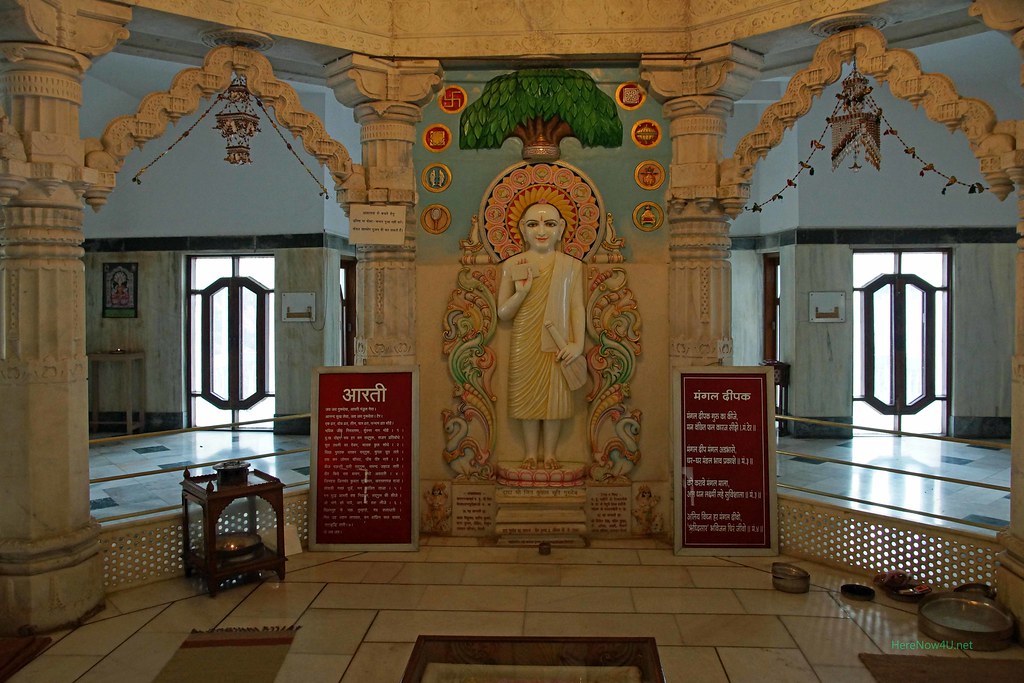
In it was this colourful depiction of a Dada Guru.
It was here that we heard details concerning the specialty of Chhoti Dadabari Jain Mandir disclosed in its name already. Dadabari is signifying a garden-like areal where a complex of temples is erected to honour the Dada Gurus. Such a complex of temples includes a temple dedicated to a Tirthankara, one rather simple building honouring the Dada Gurus, as well as educational institutions with accommodation facilities. This Dadabari showed some more depictions of the Dada Gurus, as well as lovely depictions of Tirthankaras.
A Jain temple always is erected in honour of a special Tirthankara who mostly is posed in the central point, the sanctum of the building. In Jainism Tirthankaras are venerable because they have succeeded in covering the distance to self-purification and liberation, having attained enlightenment, free of all Karma.
Liberated souls are called siddhas. Those among them who have again proclaimed and renewed the teachings of Jainism before leaving are called Tirthankara.
This last preaching is a highly cosmic event, attended by living beings from near and far (not only gods, humans, and animals). The Tirthankara explains the higher reality and is understood directly by his audience without making language detours.
Last Tirthankara of this era was Mahavira, 24nd.
In Jainism soul is seen as original and different from body. A process including subtle levels results in embodiment, taking birth. Causal responsibility is ascribed to karma particles, which can be brought to mind as choicest subatomic particles, with inertia of zero. The karma particles can celebrate manifold connections with the soul and direct it to materialization by continuously forming structure patterns.
A Tirthankara reciprocally has passed this process, and his doctrine includes the know-how (right knowledge) of dissolving karmic bondage and the therefrom derived guidelines and rules for day-to-day life. They are so simple that even the most ordinary people can take them to heart, if they possess the power of faith, to go on this very long path, i.e. to follow their preceding Tirthankara.
All this converges to a very tight atmosphere in a temple. Not only the figures of the Tirthankaras are, but also the interior of the temple is powerfully charged with this spirit and strengthens the believer. These are very subtle vibrations which can be traced, leading out of time and space. Images and structures are appearing in front of the inner eyes of those ready to plunge into silence, looking for dialogue with the pure soul.
Tirthankaras are indicating the direction. Heart can follow. Mind cannot. Mind is not made for this, which is beyond its capacity. And that is the problem for a human being, solely on a rational basis.
Aparigraha Jain Geerdes
 Editor Carla Geerdes
Editor Carla Geerdes